The Influence of Osmotic Treatment, Edible Coatings Application, and Reduced Pressure on Microwave–Vacuum-Dried Carrot Properties
Abstract
1. Introduction
2. Results
2.1. Influence of Osmotic Treatment, Edible Coating, and MVD Pressure on Physical Properties of Dried Carrot
2.1.1. Dry Matter Content (DM) and Water Activity (AW)
2.1.2. Color Parameters and Absolute Color Difference (ΔE)
2.1.3. Textural Properties
2.1.4. Structure (Scanning Electron Microscopy (SEM)) Analysis
2.1.5. Sensory Evaluation of Selected Dried Carrot
2.2. Influence of Osmotic Treatment, Edible Coating, and MVD Pressure on Chemical Properties of Dried Carrot
2.2.1. Total Phenolic Content (TPC) of Fresh and MVD Carrot
2.2.2. Antioxidant Activity DPPH• and ABTS•+
2.3. Comprehensive Summary of Results
3. Materials and Methods
3.1. Materials and Experimental Procedure
3.2. Technological Methods
3.2.1. Pre-Treatment Methods
Osmotic Enrichment/Osmotic Dehydration
Edible Coatings Preparation and Application
3.2.2. Microwave––Vacuum Drying (MVD)
3.3. Physicochemical Determinations
3.3.1. Dry Matter Content, Water Activity, and Color Parameters
3.3.2. Texture Analysis
3.3.3. Structure Analysis by Scanning Electron Microscopy (SEM)
3.4. Sensory Evaluation
3.5. Chemical Determinations
3.5.1. Extract Preparation
3.5.2. Total Phenolic Content (TPC)
3.5.3. Antioxidant Activity (AA)
3.6. Statistical Analysis
4. Conclusions
Supplementary Materials
Author Contributions
Funding
Institutional Review Board Statement
Informed Consent Statement
Data Availability Statement
Conflicts of Interest
References
- McClements, D.J. Designing healthier and more sustainable ultraprocessed foods. Compr. Rev. Food Sci. Food Saf. 2024, 23, e13331. [Google Scholar] [CrossRef] [PubMed]
- Surbhi, S.; Verma, R.C.; Deepak, R.; Jain, H.K.; Yadav, K.K. A review: Food, chemical composition and utilization of carrot (Daucus carota L.) pomace. Int. J. Chem. Stud. 2018, 6, 2921–2926. [Google Scholar]
- Motegaonkar, S.; Shankar, A.; Tazeen, H.; Gunjal, M.; Payyanad, S. A comprehensive review on carrot (Daucus carota L.): The effect of different drying methods on nutritional properties and its processing as value-added foods. Sustain. Food Technol. 2024, 2, 667–688. [Google Scholar] [CrossRef]
- Ignaczak, A.; Woźniak, Ł.; Salamon, A.; Szczepańska-Stolarczyk, J.; Trych, U.; Chobot, M.; Kowalska, J.; Kowalska, H. Shaping the Physicochemical and Health-Promoting Properties of Carrot Snacks Produced by Microwave-Vacuum Drying with Preliminary Thermal and Enriching Treatment. Molecules 2024, 29, 5100. [Google Scholar] [CrossRef]
- Yusuf, E.H.; Wojdyło, A.; Lech, K.; Masztalerz, K.; Nowicka, P. The effect of combined drying process (OD-CD-VMD) on nutritional, phytochemical, and sensory profiles, and biological activities of colored dried carrot. LWT 2023, 173, 114231. [Google Scholar] [CrossRef]
- Singh, B.; Panesar, P.S.; Nanda, V. Osmotic dehydration kinetics of carrot cubes in sodium chloride solution. Int. J. Food Sci. Technol. 2008, 43, 1361–1370. [Google Scholar] [CrossRef]
- Aghbashlo, M.; Kianmehr, M.H.; Khani, S.; Ghasemi, M. Mathematical modelling of thin-layer drying of carrot. Int. Agrophys. 2009, 23, 313–317. [Google Scholar]
- Kumar, N.; Sarkar, B.C.; Sharma, H.K. Mathematical modelling of thin layer hot air drying of carrot pomace. J. Food Sci. Technol. 2012, 49, 33–41. [Google Scholar] [CrossRef] [PubMed]
- Koca Bozalan, N.; Karadeniz, F. Carotenoid profile, total phenolic content, and antioxidant activity of carrots. Int. J. Food Prop. 2011, 14, 1060–1068. [Google Scholar] [CrossRef]
- Sharma, K.D.; Karki, S.; Thakur, N.S.; Attri, S. Chemical composition, functional properties and processing of carrot—A review. J. Food Sci. Technol. 2012, 49, 22–32. [Google Scholar] [CrossRef]
- Qiu, L.; Zhang, M.; Tang, J.; Adhikari, B.; Cao, P. Innovative technologies for producing and preserving intermediate moisture foods: A review. Food Res. Int. 2019, 116, 90–102. [Google Scholar] [CrossRef] [PubMed]
- Calín-Sánchez, Á.; Lipan, L.; Cano-Lamadrid, M.; Kharaghani, A.; Masztalerz, K.; Carbonell-Barrachina, Á.A.; Figiel, A. Comparison of traditional and novel drying techniques and its effect on quality of fruits, vegetables and aromatic herbs. Foods 2020, 9, 1261. [Google Scholar] [CrossRef] [PubMed]
- de Bruijn, J.; Rivas, F.; Rodriguez, Y.; Loyola, C.; Flores, A.; Melin, P.; Borquez, R. Effect of vacuum microwave drying on the quality and storage stability of strawberries. J. Food Process. Preserv. 2016, 40, 1104–1115. [Google Scholar] [CrossRef]
- Wojdyło, A.; Figiel, A.; Legua, P.; Lech, K.; Carbonell-Barrachina, Á.A.; Hernández, F. Chemical composition, antioxidant capacity, and sensory quality of dried jujube fruits as affected by cultivar and drying method. Food Chem. 2016, 207, 170–179. [Google Scholar] [CrossRef]
- Siebert, T.; Gall, V.; Karbstein, H.P.; Gaukel, V. Serial combination drying processes: A measure to improve quality of dried carrot disks and to reduce drying time. Dry. Technol. 2018, 36, 1578–1591. [Google Scholar] [CrossRef]
- Cui, Z.W.; Xu, S.Y.; Sun, D.W. Microwave–vacuum drying kinetics of carrot slices. J. Food Eng. 2004, 65, 157–164. [Google Scholar] [CrossRef]
- Changrue, V.; Orsat, V. Osmotically dehydrated microwave vacuum drying of carrots. Can. Biosyst. Eng. 2009, 51, 311–319. [Google Scholar]
- Béttega, R.; Rosa, J.G.; Corrêa, R.G.; Freire, J.T. Comparison of carrot (Daucus carota) drying in microwave and in vacuum microwave. Braz. J. Chem. Eng. 2014, 31, 403–412. [Google Scholar] [CrossRef]
- de Souza, A.U.; Corrêa, J.L.G.; Tanikawa, D.H.; Abrahão, F.R.; de Jesus Junqueira, J.R.; Jiménez, E.C. Hybrid microwave-hot air drying of the osmotically treated carrots. LWT 2022, 156, 113046. [Google Scholar] [CrossRef]
- Ignaczak, A.; Salamon, A.; Kowalska, J.; Marzec, A.; Kowalska, H. Influence of Pre-Treatment and Drying Methods on the Quality of Dried Carrot Properties as Snacks. Molecules 2023, 28, 6407. [Google Scholar] [CrossRef]
- Kowalska, H.; Marzec, A.; Kowalska, J.; Trych, U.; Masiarz, E.; Lenart, A. The use of a hybrid drying method with pre-osmotic treatment in strawberry bio-snack technology. Int. J. Food Eng. 2020, 16, 20180318. [Google Scholar] [CrossRef]
- Zhu, J.; Liu, Y.; Zhu, C.; Wei, M. Effects of different drying methods on the physical properties and sensory characteristics of apple chip snacks. LWT 2022, 154, 112829. [Google Scholar] [CrossRef]
- Wang, H.; Karim, M.A.; Vidyarthi, S.K.; Xie, L.; Liu, Z.L.; Gao, L.; Zhang, J.S.; Xiao, H.W. Vacuum-steam pulsed blanching (VSPB) softens texture and enhances drying rate of carrot by altering cellular structure, pectin polysaccharides and water state. Innov. Food Sci. Emerg. Technol. 2021, 74, 102801. [Google Scholar] [CrossRef]
- Wang, H.; Meng, J.S.; Raghavan, G.S.V.; Orsat, V.; Yu, X.L.; Liu, Z.L.; Zheng, Z.A.; Wang, S.Y.; Xiao, H.W. Vacuum-steam pulsed blanching (VSPB) enhances drying quality, shortens the drying time of gingers by inactivating enzymes, altering texture, microstructure and ultrastructure. LWT 2022, 154, 112714. [Google Scholar] [CrossRef]
- Wang, H.; Zielinska, M.; An, K.; Fang, X.M.; Raghavan, G.S.V.; Zhang, Y.; Orsat, V.; Xiao, H.M.; Xiao, H.W. Effects of vacuum-steam pulsed blanching (VSPB) and storage on β-carotene, color, total phenolics, antioxidant capacity and volatile profiles of dried carrots. LWT 2023, 183, 114894. [Google Scholar] [CrossRef]
- Akharume, F.; Smith, A.; Sivanandan, L.; Singh, K. Recent progress on osmo-convective dehydration of fruits. J. Food Sci. Technol. 2019, 4, 956–969. [Google Scholar] [CrossRef]
- González-Pérez, J.E.; Ramírez-Corona, N.; López-Malo, A. Mass transfer during osmotic dehydration of fruits and vegetables: Process factors and non-thermal methods. Food Eng. Rev. 2021, 13, 344–374. [Google Scholar] [CrossRef]
- Kowalska, H.; Woźniak, Ł.; Masiarz, E.; Stelmach, A.; Salamon, A.; Kowalska, J.; Piotrowski, D.; Marzec, A. The impact of using polyols as osmotic agents on mass exchange during osmotic dehydration and their content in osmodehydrated and dried apples. Dry. Technol. 2020, 38, 1620–1631. [Google Scholar] [CrossRef]
- Lech, K.; Figiel, A.; Michalska, A.; Wojdyło, A.; Nowicka, P. The effect of selected fruit juice concentrates used as osmotic agents on the drying kinetics and chemical properties of vacuum-microwave drying of pumpkin. J. Food Qual. 2018, 2018, 7293932. [Google Scholar] [CrossRef]
- Kowalska, H.; Marzec, A.; Domian, E.; Masiarz, E.; Ciurzyńska, A.; Galus, S.; Małkiewicz, A.; Lenart, A.; Kowalska, J. Physical and sensory properties of japanese quince chips obtained by osmotic dehydration in fruit juice concentrates and hybrid drying. Molecules 2020, 25, 5504. [Google Scholar] [CrossRef]
- Villafañe, F. Edible coatings for carrots. Food Rev. Int. 2017, 33, 84–103. [Google Scholar] [CrossRef]
- Keshari, D.; Tripathi, A.D.; Agarwal, A.; Rai, S.; Srivastava, S.K.; Kumar, P. Effect of α-dl tocopherol acetate (antioxidant) enriched edible coating on the physicochemical, functional properties and shelf life of minimally processed carrots (Daucus carota subsp. sativus). Future Foods 2022, 5, 100116. [Google Scholar] [CrossRef]
- Olunusi, S.O.; Ramli, N.H.; Fatmawati, A.; Ismail, A.F.; Okwuwa, C.C. Revolutionizing tropical fruits preservation: Emerging edible coating technologies. Int. J. Biol. Macromol. 2024, 264, 130682. [Google Scholar] [CrossRef]
- Barrera-Chamorro, L.; Fernandez-Prior, Á.; Rivero-Pino, F.; Montserrat-de la Paz, S. A comprehensive review on the functionality and biological relevance of pectin and the use in the food industry. Carbohydr. Polym. 2025, 348, 122794. [Google Scholar] [CrossRef] [PubMed]
- Khalid, M.A.; Niaz, B.; Saeed, F.; Afzaal, M.; Islam, F.; Hussain, M.; Mahwish Khalid, H.M.S.; Siddeeg, A.; Al-Farga, A. Edible coatings for enhancing safety and quality attributes of fresh produce: A comprehensive review. Int. J. Food Prop 2022, 25, 1817–1847. [Google Scholar] [CrossRef]
- Malakar, S. Active edible coating combined with novel pre-treatment technique for drying of foods: Mechanistic insights, enhancing drying performance and product quality. Food Biosci. 2024, 60, 104527. [Google Scholar] [CrossRef]
- Pradeepa, B.; Kiruthika, A.V. Properties of Sodium Alginate Gum for the Fabrication of Composites. Mater. Circ. Econ. 2024, 6, 49. [Google Scholar] [CrossRef]
- Senturk Parreidt, T.; Müller, K.; Schmid, M. Alginate-based edible films and coatings for food packaging applications. Foods 2018, 7, 170. [Google Scholar] [CrossRef]
- Mina, Z.P.; Kaseke, T.; Fadiji, T.; Fawole, O.A. Effect of gum Arabic and ethanol pretreatments on drying kinetics and quality attributes of dried carrot slices. Heliyon 2022, 8, e12037. [Google Scholar] [CrossRef]
- Kowalska, H.; Marzec, A.; Domian, E.; Kowalska, J.; Ciurzyńska, A.; Galus, S. Edible coatings as osmotic dehydration pretreatment in nutrient-enhanced fruit or vegetable snacks development: A review. Compr. Rev. Food Sci. Food Saf. 2021, 20, 5641–5674. [Google Scholar] [CrossRef]
- Pałacha, Z.; Makarewicz, M. Water activity of choosen food-stuff groups. Adv. Food Process. Technol. 2011, 2, 24–29. (In Polish) [Google Scholar]
- Wang, H.; Fang, X.M.; Sutar, P.P.; Meng, J.S.; Wang, J.; Yu, X.L.; Xiao, H.W. Effects of vacuum-steam pulsed blanching on drying kinetics, colour, phytochemical contents, antioxidant capacity of carrot and the mechanism of carrot quality changes revealed by texture, microstructure and ultrastructure. Food Chem. 2021, 338, 127799. [Google Scholar] [CrossRef]
- Doymaz, İ. Drying kinetics, rehydration and colour characteristics of convective hot-air drying of carrot slices. Heat Mass Transf. 2017, 53, 25–35. [Google Scholar] [CrossRef]
- Keser, D.; Guclu, G.; Kelebek, H.; Keskin, M.; Soysal, Y.; Sekerli, Y.E.; Arslan, A.; Selli, S. Characterization of aroma and phenolic composition of carrot (Daucus carota ‘Nantes’) powders obtained from intermittent microwave drying using GC–MS and LC–MS/MS. Food Bioprod. Process. 2020, 119, 350–359. [Google Scholar] [CrossRef]
- Amin, M.R.; Sharmin, T.; Ahmed, S.; Bari, M.S.; Mahomud, M.S.; Roy, J. Effect of microwave output power on the kinetics of color change, physicochemical and bioactive constituent features of pre-treated carrot slices. Appl. Food Res. 2024, 4, 100452. [Google Scholar] [CrossRef]
- de Mendonça, K.S.; Corrêa, J.L.G.; de Jesus Junqueira, J.R.; de Carvalho, E.E.N.; Silveira, P.G.; Uemura, J.H.S. Peruvian carrot chips obtained by microwave and microwave-vacuum drying. LWT 2023, 187, 115346. [Google Scholar] [CrossRef]
- Michalska, A.; Wojdyło, A.; Lech, K.; Łysiak, G.P.; Figiel, A. Physicochemical properties of whole fruit plum powders obtained using different drying technologies. Food Chem. 2016, 207, 223–232. [Google Scholar] [CrossRef]
- Castillo-Gironés, S.; Masztalerz, K.; Lech, K.; Issa-Issa, H.; Figiel, A.; Carbonell-Barrachina, A.A. Impact of osmotic dehydration and different drying methods on the texture and sensory characteristic of sweet corn kernels. J. Food Process. Preserv. 2021, 45, e15383. [Google Scholar] [CrossRef]
- Ciurzyńska, A.; Janowicz, M.; Karwacka, M.; Galus, S.; Kowalska, J.; Gańko, K. The effect of hybrid drying methods on the quality of dried carrot. App. Sci. 2022, 12, 10588. [Google Scholar] [CrossRef]
- Xu, Y.; Lang, X.; Xiao, Y.; Li, D.; Liu, C.; Song, J.; Zhang, Z.; Liu, C.; Jiang, N.; Zhang, M. Study on drying efficiency, uniformity, and physicochemical characteristics of carrot by tunnel microwave drying combined with explosion puffing drying. Dry. Technol. 2022, 40, 416–429. [Google Scholar] [CrossRef]
- Karwacka, M.; Galus, S.; Janowicz, M. Development and physicochemical characteristics of multicomponent freeze-dried snacks obtained with blackcurrant pomace powder and calcium ions as structuring agents. J. Food Sci. Technol. 2024, 61, 1363–1373. [Google Scholar] [CrossRef] [PubMed]
- Mohammadi, X.; Deng, Y.; Matinfar, G.; Singh, A.; Mandal, R.; Pratap-Singh, A. Impact of three different dehydration methods on nutritional values and sensory quality of dried broccoli, oranges, and carrots. Foods 2020, 9, 1464. [Google Scholar] [CrossRef] [PubMed]
- Baryga, A.; Ziobro, R.; Gumul, D.; Rosicka-Kaczmarek, J.; Miśkiewicz, K. Physicochemical properties and evaluation of antioxidant potential of sugar beet pulp—Preliminary analysis for further use (future prospects). Agriculture 2023, 13, 1039. [Google Scholar] [CrossRef]
- Samborska, K.; Eliasson, L.; Marzec, A.; Kowalska, J.; Piotrowski, D.; Lenart, A.; Kowalska, H. The effect of adding berry fruit juice concentrates and by-product extract to sugar solution on osmotic dehydration and sensory properties of apples. J. Food Sci. Technol. 2019, 56, 1927–1938. [Google Scholar] [CrossRef] [PubMed]
- Kowalska, J.; Lenart, A.; Roszkowska, S.; Kowalska, H. The influence of chokeberry juice and inulin as osmotic-enriching agents in pre-treatment on polyphenols content and sensory quality of dried strawberries. Agric. Food Sci. 2019, 28, 190–199. [Google Scholar] [CrossRef]
- Han, Z.; Zhu, M.; Wan, X.; Zhai, X.; Ho, C.T.; Zhang, L. Food polyphenols and Maillard reaction: Regulation effect and chemical 1479 mechanism. Crit. Rev. Food Sci. Nut. 2022, 64, 4904–4920. [Google Scholar] [CrossRef]
- Sagar, V.R.; Suresh Kumar, P. Recent advances in drying and dehydration of fruits and vegetables: A review. J. Food Sci. Technol. 2010, 47, 15–26. [Google Scholar] [CrossRef]
- Özcan, M.M.; Al Juhaimi, F.; Ahmed, I.A.M.; Uslu, N.; Babiker, E.E.; Ghafoor, K. Effect of microwave and oven drying processes on antioxidant activity, total phenol and phenolic compounds of kiwi and pepino fruits. J. Food Sci. Technol. 2020, 57, 233–242. [Google Scholar] [CrossRef]
- Babaei Rad, S.; Mumivand, H.; Mollaei, S.; Khadivi, A. Effect of drying methods on phenolic compounds and antioxidant activity of Capparis spinosa L. fruits. BMC Plant Biol. 2025, 25, 133. [Google Scholar] [CrossRef]
- Minutti-López Sierra, P.; Gallardo-Velázquez, T.; Osorio-Revilla, G.; Meza-Márquez, O.G. Chemical composition and antioxidant capacity of strawberry varieties (Fragaria × ananassa Duch.) by FT-MIR spectroscopy and chemometrics. CyTA—J. Food 2019, 17, 724–732. [Google Scholar] [CrossRef]
- Rybicka, I.; Kiewlicz, J.; Kowalczewski, P.Ł.; Gliszczyńska-Świgło, A. Select dried fruits as a source of nutrients. Eur. Food Res. Technol. 2021, 247, 2409–2419. [Google Scholar] [CrossRef]
- Marzec, A.; Kowalska, H.; Zadrożna, M. Analysis of instrumental and sensory texture attributes of microwave–convective dried apples. J. Texture Stud. 2010, 41, 417–439. [Google Scholar] [CrossRef]
- Kowalska, H.; Trusinska, M.; Rybak, K.; Wiktor, A.; Witrowa-Rajchert, D.; Nowacka, M. Shaping the Properties of Osmo-Dehydrated Strawberries in Fruit Juice Concentrates. Appl. Sci. 2023, 13, 2728. [Google Scholar] [CrossRef]
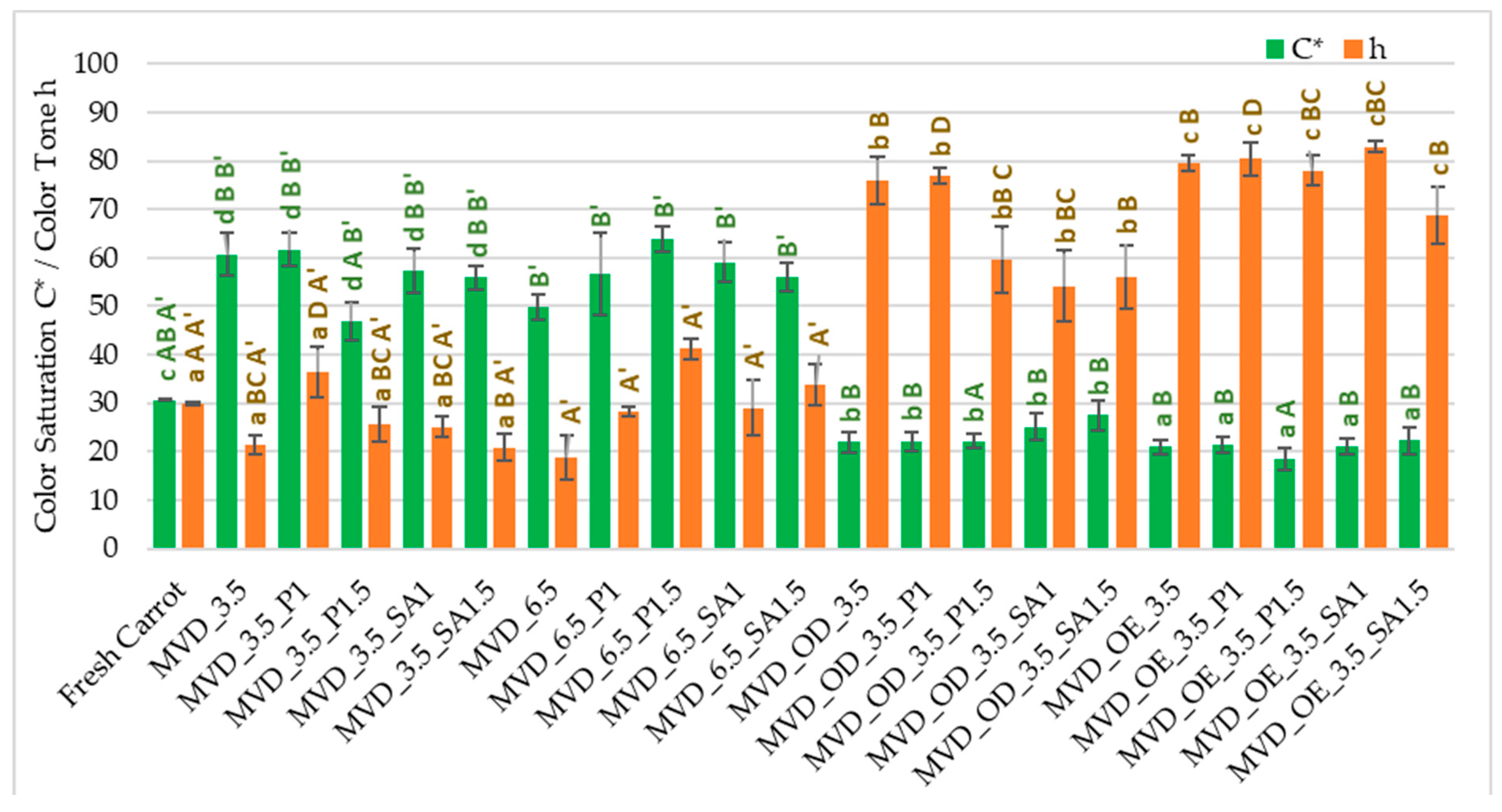
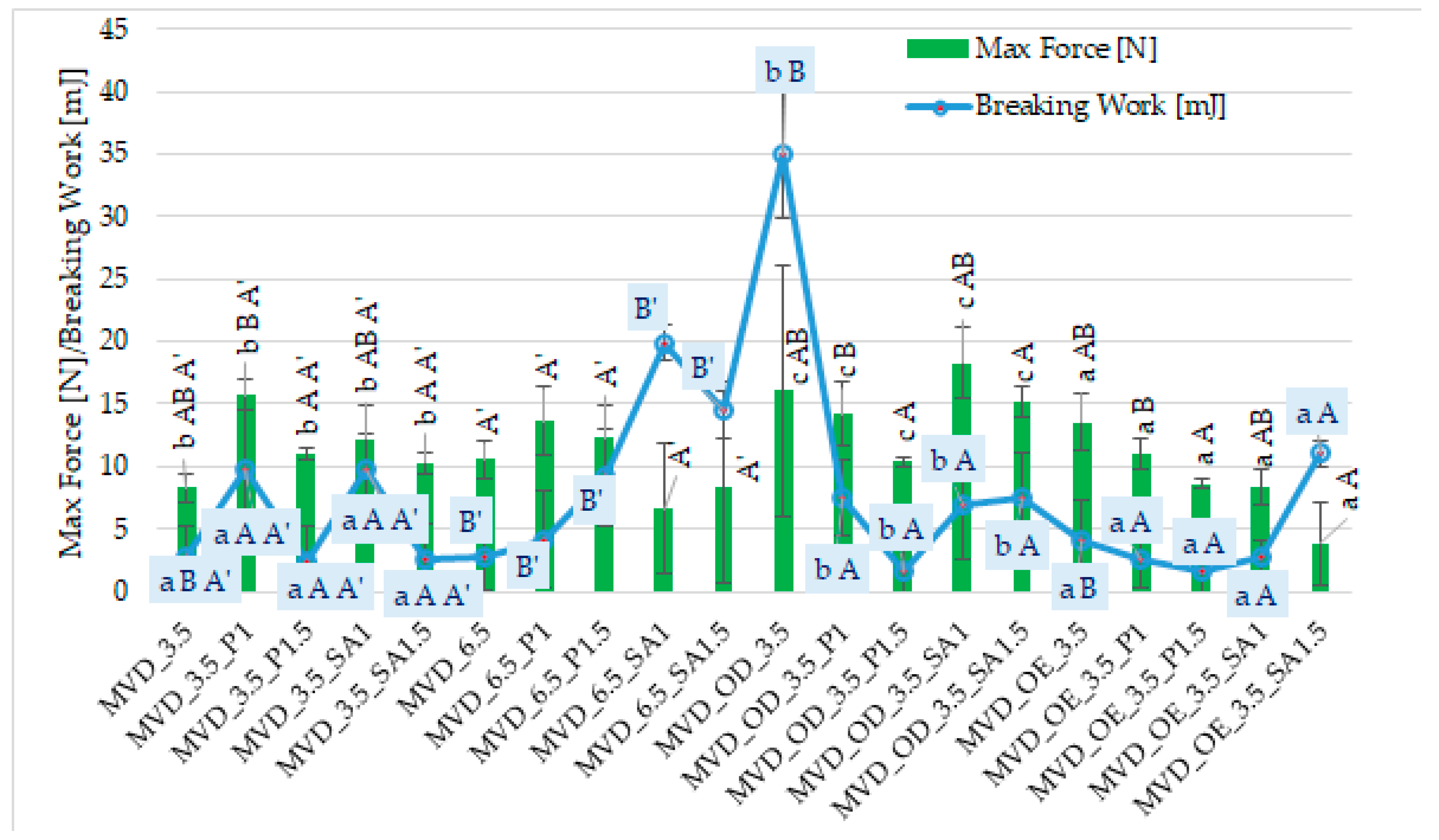


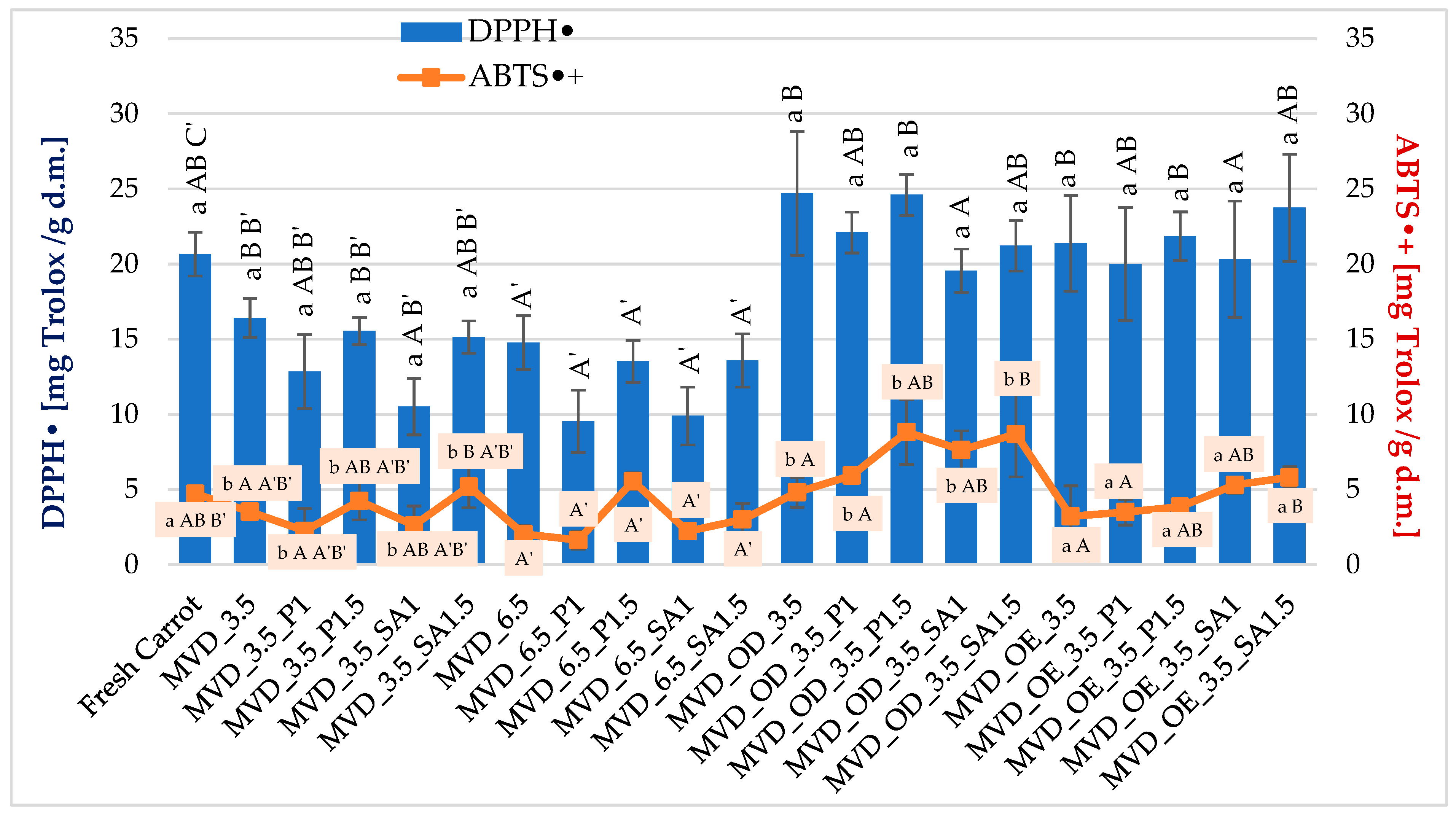


| Type of Sample | Dry Matter Content, DM [%] | Water Activity, AW [-] | |||
|---|---|---|---|---|---|
| 1. | Fresh Carrot | 13.51 ± 0.48 | 0.983 ± 0.00 | ||
| 2. | MVD_3.5 | 95.95 ± 0.33 | 0.427 ± 0.01 | ||
| 3. | MVD_3.5_P1 | 91.49 ± 0.29 | 0.424 ± 0.00 | ||
| 4. | MVD_3.5_P1.5 | 95.57 ± 0.93 | 0.334 ± 0.00 | ||
| 5. | MVD_3.5_SA1 | 91.68 ± 1.41 | 0.416 ± 0.00 | ||
| 6. | MVD_3.5_SA1.5 | 96.05 ± 0.28 | 0.332 ± 0.01 | ||
| 7. | MVD_6.5 | 93.44 ± 0.42 | 0.456 ± 0.01 | ||
| 8. | MVD_6.5_P1 | 93.58 ± 0.07 | 0.430 ± 0.00 | ||
| 9. | MVD_6.5_P1.5 | 88.30 ± 0.63 | 0.503 ± 0.01 | ||
| 10. | MVD_6.5_SA1 | 84.60 ± 0.67 | 0.578 ± 0.00 | ||
| 11. | MVD_6.5_SA1.5 | 85.26 ± 0.03 | 0.589 ± 0.00 | ||
| 12. | MVD_OD_3.5 | 95.08 ± 0.98 | 0.277 ± 0.01 | ||
| 13. | MVD_OD_3.5_P1 | 96.58 ± 0.93 | 0.258 ± 0.00 | ||
| 14. | MVD_OD_3.5_P1.5 | 97.99 ± 0.02 | 0.164 ± 0.00 | ||
| 15. | MVD_OD_3.5_SA1 | 96.44 ± 1.34 | 0.285 ± 0.00 | ||
| 16. | MVD_OD_3.5_SA1.5 | 94.71 ± 0.89 | 0.269 ± 0.02 | ||
| 17. | MVD_OE_3.5 | 99.52 ± 0.14 | 0.235 ± 0.02 | ||
| 18. | MVD_OE_3.5_P1 | 98.31 ± 0.36 | 0.239 ± 0.02 | ||
| 19. | MVD_OE_3.5_P1.5 | 99.08 ± 0.18 | 0.237 ± 0.00 | ||
| 20. | MVD_OE_3.5_SA1 | 99.31 ± 0.37 | 0.266 ± 0.00 | ||
| 21. | MVD_OE_3.5_SA1.5 | 97.22 ± 0.93 | 0.260 ± 0.00 | ||
| One-factor analysis of variance (*—significance effect when p ≤ 0.05) | |||||
| Factors | P-probability/Homogenous groups | ||||
| Type of osmotic treatment (a, b, c); analyzed samples: 2–6, 12–21 | 0.0001 * | No a OD b OE c | 0.0000 * | No b OD a OE a | |
| Coating type and concentration (A); analyzed samples: 2–6, 12–21 | 0.6122 | No A SA1 A SA1.5 A P1 A P1.5 A | 0.4346 | No A SA1 A SA1.5 A P1 A P1.5 A | |
| Drying pressure (A’, B’); analyzed samples: 2–11 | 0.0028 * | 3.5 A’ 6.5 B’ | 0.0001 * | 3.5 A’ 6.5 B’ | |
| Correlation (**—significance effect when p ≤ 0.05) | |||||
| Dry Matter/Water Activity −0.9050 ** | |||||
| Type of Sample | Parameter L* | Parameter a* | Parameter b* | ΔE | |||||
|---|---|---|---|---|---|---|---|---|---|
| 1. | Fresh Carrot | 40.24 ± 0.09 | 15.28 ± 0.12 | 26.53 ± 0.21 | - | ||||
| 2. | MVD_3.5 | 59.32 ± 4.47 | 12.74 ± 2.06 | 32.46 ± 3.85 | 20.45 ± 4.85 | ||||
| 3. | MVD_3.5_P1 | 51.14 ± 0.91 | 34.16 ± 5.72 | 46.22 ± 2.17 | 29.73 ± 3.49 | ||||
| 4. | MVD_3.5_P1.5 | 44.13 ± 4.49 | 15.43 ± 2.82 | 32.06 ± 2.48 | 7.96 ± 3.49 | ||||
| 5. | MVD_3.5_SA1 | 52.43 ± 4.19 | 22.92 ± 3.08 | 48.78 ± 3.26 | 26.69 ± 5.01 | ||||
| 6. | MVD_3.5_SA1.5 | 53.99 ± 2.77 | 14.23 ± 1.91 | 37.45 ± 1.87 | 17.78 ± 2.50 | ||||
| 7. | MVD_6.5 | 49.17 ± 2.83 | 6.87 ± 1.51 | 20.13 ± 1.07 | 14.03 ± 2.17 | ||||
| 8. | MVD_6.5_P1 | 52.98 ± 8.45 | 19.91 ± 2.21 | 37.06 ± 4.55 | 17.60 ± 8.85 | ||||
| 9. | MVD_6.5_P1.5 | 52.07 ± 1.57 | 36.94 ± 2.54 | 42.13 ± 0.94 | 29.26 ± 2.27 | ||||
| 10. | MVD_6.5_SA1 | 51.97 ± 3.12 | 27.54 ± 6.29 | 49.28 ± 3.42 | 28.92 ± 4.74 | ||||
| 11. | MVD_6.5_SA1.5 | 47.99 ± 0.99 | 28.48 ± 4.41 | 42.50 ± 3.30 | 22.38 ± 4.13 | ||||
| 12. | MVD_OD_3.5 | 20.25 ± 1.67 | 8.44 ± 1.69 | 2.18 ± 1.03 | 32.26 ± 2.06 | ||||
| 13. | MVD_OD_3.5_P1 | 20.88 ± 1.82 | 7.32 ± 0.77 | 1.72 ± 0.39 | 32.48 ± 1.44 | ||||
| 14. | MVD_OD_3.5_P1.5 | 21.84 ± 1.43 | 3.65 ± 1.02 | 2.11 ± 0.67 | 32.74 ± 1.24 | ||||
| 15. | MVD_OD_3.5_SA1 | 24.19 ± 2.67 | 6.69 ± 1.61 | 4.87 ± 1.43 | 28.35 ± 2.74 | ||||
| 16. | MVD_OD_3.5_SA1.5 | 26.26 ± 2.75 | 8.03 ± 1.70 | 5.60 ± 2.09 | 26.24 ± 3.42 | ||||
| 17. | MVD_OE_3.5 | 19.26 ± 1.80 | 8.24 ± 0.89 | 1.54 ± 0.38 | 33.42 ± 0.97 | ||||
| 18. | MVD_OE_3.5_P1 | 19.81 ± 1.47 | 8.29 ± 1.19 | 1.46 ± 0.65 | 33.11 ± 1.56 | ||||
| 19. | MVD_OE_3.5_P1.5 | 18.12 ± 2.20 | 3.92 ± 0.76 | 0.84 ± 0.28 | 35.78 ±1.71 | ||||
| 20. | MVD_OE_3.5_SA1 | 19.99 ± 1.63 | 6.23 ± 1.44 | 0.79 ± 0.26 | 34.02 ± 1.18 | ||||
| 21. | MVD_OE_3.5_SA1.5 | 21.87 ± 2.55 | 3.89 ± 1.15 | 1.42 ± 0.19 | 33.19 ± 1.72 | ||||
| One-factor analysis of variance (*—significance effect when p ≤ 0.05) | |||||||||
| Factors | P-probability/ Homogenous groups | ||||||||
| Type of osmotic treatment (a, b, c, d); analyzed samples: 1–6, 12–21 | 0.0000 * | Fresh c No d OD b OE a | 0.0000 * | Fresh b No b OD a OE a | 0.0000 * | Fresh b No c OD a OE a | 0.0000 * | - No a OD b OE c | |
| Coating type and concentration (A, B, C); analyzed samples: 1–6, 12–21 | 0.0021 * | Fresh C No B SA1 B SA1.5 B P1 AB P1.5 A | 0.0001 * | Fresh BC No AB SA1 AB SA1.5 A P1 C P1.5 A | 0.0000 * | Fresh C No A SA1 B SA1.5 AB P1 B P1.5 A | 0.0121 * | - No AB SA1 AB SA1.5 A P1 AB P1.5 B | |
| Drying pressure (A’, B’); analyzed samples: 2–11 | 0.0001 * | Fresh A’ 3.5 B’ 6.5 B’ | 0.1137 | Fresh A’ 3.5 A’ 6.5 A’ | 0.0148 * | Fresh A’ 3.5 B’ 6.5 B’ | 0.4094 | - 3.5 A’ 6.5 A’ | |
| Correlation (**—significance effect when p < 0.05) | |||||||||
| L*/a* | L*/b* | a*/b* | L*/ΔE | a*/ΔE | b*/ΔE | ||||
| 0.7325 ** | 0.9403 ** | 0.8777 | −0.6800 | −0.2142 | −0.5278 | ||||
| Sample | A | B | C |
|---|---|---|---|
| MVD_3.5 |  |  |  |
| MVD_6.5 | 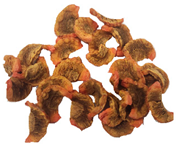 | 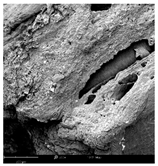 | 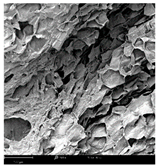 |
| MVD_3.5_P1.5 |  | 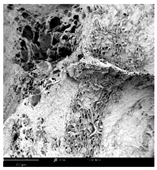 |  |
| MVD_6.5_SA1.5 | 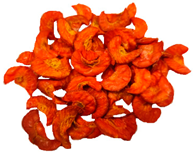 | 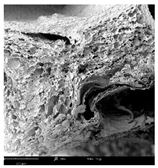 | 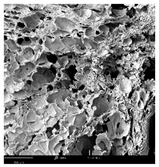 |
| MVD_OD_3.5_SA1 |  | 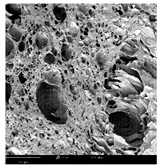 |  |
| MVD_OE_3.5_P1 |  |  | 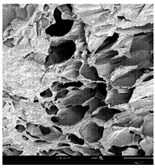 |
Disclaimer/Publisher’s Note: The statements, opinions and data contained in all publications are solely those of the individual author(s) and contributor(s) and not of MDPI and/or the editor(s). MDPI and/or the editor(s) disclaim responsibility for any injury to people or property resulting from any ideas, methods, instructions or products referred to in the content. |
© 2025 by the authors. Licensee MDPI, Basel, Switzerland. This article is an open access article distributed under the terms and conditions of the Creative Commons Attribution (CC BY) license (https://creativecommons.org/licenses/by/4.0/).
Share and Cite
Ignaczak, A.; Woźniak, Ł.; Marzec, A.; Kowalska, J.; Chobot, M.; Kowalska, H. The Influence of Osmotic Treatment, Edible Coatings Application, and Reduced Pressure on Microwave–Vacuum-Dried Carrot Properties. Molecules 2025, 30, 1877. https://doi.org/10.3390/molecules30091877
Ignaczak A, Woźniak Ł, Marzec A, Kowalska J, Chobot M, Kowalska H. The Influence of Osmotic Treatment, Edible Coatings Application, and Reduced Pressure on Microwave–Vacuum-Dried Carrot Properties. Molecules. 2025; 30(9):1877. https://doi.org/10.3390/molecules30091877
Chicago/Turabian StyleIgnaczak, Anna, Łukasz Woźniak, Agata Marzec, Jolanta Kowalska, Małgorzata Chobot, and Hanna Kowalska. 2025. "The Influence of Osmotic Treatment, Edible Coatings Application, and Reduced Pressure on Microwave–Vacuum-Dried Carrot Properties" Molecules 30, no. 9: 1877. https://doi.org/10.3390/molecules30091877
APA StyleIgnaczak, A., Woźniak, Ł., Marzec, A., Kowalska, J., Chobot, M., & Kowalska, H. (2025). The Influence of Osmotic Treatment, Edible Coatings Application, and Reduced Pressure on Microwave–Vacuum-Dried Carrot Properties. Molecules, 30(9), 1877. https://doi.org/10.3390/molecules30091877







